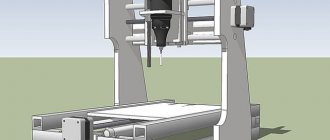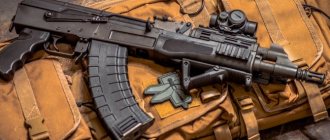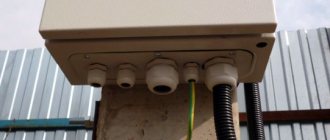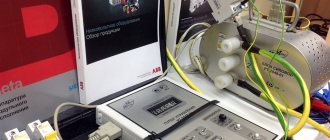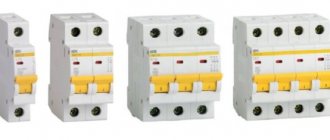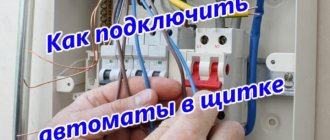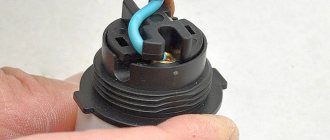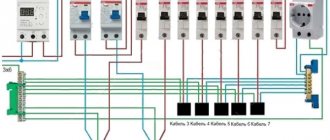Now are the times when the value of human life has become the main priority, and at the same time there are excesses - many restrictions and innovations are justified by safety. Today we will talk again about electrical safety, which is provided by a home electrical panel, through the prism of knowledge about short circuit current. Yes, this is not the first time I have raised this topic. But don’t rush to close the website! The topic concerns everyone - after all, it is a security topic! Spoiler: I will prove that panels equipped with machines with characteristic “B” are much more preferable for our houses and apartments.
In recent years, some restrictions and innovations have been introduced in the electrical engineering field, which serve primarily two purposes - preserving human life and preserving the life of equipment (from general to specific - electrical networks, electrical installations, loads). Fortunately, modern technologies and devices make it possible to ensure the safety of both people and wires.
Here is a partial list of the protections in our electrical panels that I am talking about:
- Automatic switches (AB), which turn off the power during overloads and short circuits. This is the only device in our electrical panels, the installation of which is strictly required in any case.
- Residual current devices (RCDs), or in the new-fashioned way, residual current switches (RCCBs), which turn off the power when a dangerous value of differential current appears (its appearance means that a dangerous and even fatal potential for humans may arise on the housings of the devices). This also includes RCBOs (automatic residual current switches), which are hybrids of AV and RCCBs.
- Voltage relays that turn off the power and thus protect equipment from overvoltage and undervoltage;
- Arc flash protection devices (AFDs) or anti-sparking devices (AFDs), which turn off the power if any kind of spark is suspected, even at low current.
- Surge protection devices (SPDs) or surge limiters (OSLs), which stop, to the best of their ability, powerful short-term voltage surges that can be caused by natural or man-made causes. Depending on the circuit configuration, the power in this case is also usually turned off.
On the one hand, people have become richer, and now many can afford electronic “things” that previously could only be dreamed of. On the other hand, these “things” have become more accessible in price and availability.
Some people say that this is “swindling the client out of money,” but I don’t agree with that. If the client values his life, is ready to pay for it, and understands what it is and why, then all possible protections must be put in place.
It is important that the installation of any protection must be justified, and its characteristics must be carefully calculated. After all, no protection, even the most necessary one, should be unnecessarily complex and ruin your nerves due to false positives.
Among illiterate electricians there is such a criterion for choosing a machine - “So as not to knock it out.”
In the article we will talk about how to most effectively protect electrical appliances and electrical wiring from short circuits (short circuits). This is done thanks to an innovation that enters our lives with great difficulty, despite the penny costs. The reason for this is the inertia of the Russian mentality, its ignorance and fears. Which I will dispel in this article.
For completeness, I recommend that you read my previous articles on this topic - “Short-circuit current: size matters” and “Selectivity in a home panel: how to achieve the impossible.”
First, as usual, a little background information.
Take care of the cable, Sanya!
On the issue of restrictions, it is worth mentioning that the requirements for the thermal conditions of cables have become more stringent. Although I don’t remember changes in regulatory and technical documentation (NTD) that could have caused this to happen. But I perfectly remember the surprised and indignant eyes of the senior electrician Ivanovich at one of my first objects, when he told me: “What 16? All my life the sockets were set to 25 amps! Don't be smart! And now putting 16 A on socket lines with a copper cross-section of 2.5 mm2 is the norm.
I think this happened for two reasons:
- Previously, half an apartment could hang on one 25 A circuit breaker, which meant several sockets, plus several incandescent light bulbs. This was due to poverty - this way you can save on wires and on machines, of which there were usually two or three per apartment. In this case, the current on the line was relatively large, and with a rating of 16 A there would be relatively frequent outages due to overload. Therefore, we found such a compromise. Now on one 16 A machine there are usually a maximum of three sockets “hanging”, and the lighting is connected separately.
- More attention has been paid to the survivability and reliability of the cable. The main thing that determines its service life is the operating temperature. More precisely, the boundaries of temperature differences and their frequency. The more frequent and greater the changes (the more often and more the core heats up), the faster the insulation dries and loses resistance, and the faster the contacts at the joints deteriorate. The main factor influencing the heating of the core is current. Hence the logical conclusion - by limiting the current, we limit possible heating and increase the service life of the cable. In this sense, it turns out that to protect a cable with a cross-section of 2.5 mm2, a machine with a rating of 16 A has priority over 20 A, and even more so 25 A.
The permissible heating temperature of the cable cores for most cables is 70 °C. For more details, see GOST 31996-2012. The cross-sections and resistances of current-carrying conductors are described in GOST 22483-2012.
In addition, the new standards (SP 256.1325800.2016, amendment 3 of 2019, table 15.3) say that the cable of the socket group cannot have a cross-section of less than 2.5 mm2. That is, there is no way to save on cable now, even if a refrigerator with a power of 200 W “hangs” on this line, and the rating of the machine is 6 A. If the line to the sockets is laid with a cable with aluminum conductors, its cross-section must be at least 4 mm2.
Aluminum cable is changing its properties and may soon officially appear in our homes. Read about this in the previous issue of the magazine.
Using cable as an example, we can say that the operating modes of many electrical network components have become more gentle, and the components themselves are better protected.
The ratio of AV ratings and consumer power
To determine how many kilowatts can be connected through a circuit breaker of a certain power, use the table:
| automatic 220v, A | power, kWt | |
| single-phase | three-phase | |
| 2 | 0,4 | 1,3 |
| 6 | 1,3 | 3,9 |
| 10 | 2,2 | 6,6 |
| 16 | 3,5 | 10,5 |
| 20 | 4,4 | 13,2 |
| 25 | 5,5 | 16,4 |
| 32 | 7,0 | 21,1 |
| 40 | 8,8 | 26,3 |
| 50 | 11,0 | 32,9 |
| 63 | 13,9 | 41,4 |
To calculate the power of the introductory machine at home, use a coefficient of 0.7 of the total power of consumers.
When determining the load capacity of a circuit breaker, it is important to take into account not only its rating, but also the overload characteristic. This will help avoid false alarms when starting powerful electrical appliances.
If your 16-20 A circuit breaker often trips and de-energizes your apartment, do not believe those who say that you just need to install a circuit breaker with a higher rating. The new machine will stop responding to overloads, but the sockets will start to light up.
Short circuit protection
The most important point in this matter is that with such a formidable phenomenon as a short circuit, the eyes of all the inhabitants of the apartment are hopefully turned to the electromagnetic release, which is an integral part of every modern circuit breaker. It is he who saves all participants in the electrical circuit - from the short circuit to the AB terminals.
What guarantees can the machine provide us in the event of a short circuit? To answer this question, it is fundamentally important to know the ratio of the short-circuit current and the “nominal” of the electromagnetic (EM) release (current multiplicity). The main and only condition for turning off the circuit in such incidents is that the operating current of the EM release in any case must be less than the expected short-circuit current.
Otherwise, the thermal release will have to take over, but it works reluctantly, lazily - unlike its electromagnetic partner. As a result, in a few agonizing seconds, until the thermal release gives the command to open, something irreparable can happen. For example, the twist of aluminum and copper that a young tiler made when he moved an outlet in the bathroom will burn out.
Knowing the expected short-circuit current and the release characteristic (in the case of a home panel it is “B” or “C”), we can say for sure whether the machine will be able to save the situation in the event of a short circuit (we talked about this in other articles). But in most cases, we know the short-circuit current only approximately - after all, it can change unpredictably due to many factors. What to do?
My answer is this. We play it safe with the cable by lowering the expected current (limiting it) using the rated current AB. But it is not always possible to lower the rating of the machine - it is limited by the rated current consumed by the load. This means that you need to lower the “rating” of the EM release. But this must be done wisely - so as to ensure circuit breakage at extremely low short-circuit currents, while at the same time not limiting the load in any way. Logical reinsurance?
In other words, you need to “lower the letter” of the electromagnetic release from “C” to “B” in order to get more shutdown guarantees during a short circuit. How to do this, ensuring maximum protection, and at the same time eliminating false positives? The answer will be in this article.
Representatives of circuit breakers of families “B” and “C” with a rated current of 10 A
Why change the machine?
Any electrician will say: “If there is no urgent need, it is better not to get into the electrical wiring of the house with your own hands.” The consequences can be dire. When does such a need arise?
In order to change the socket, you need to know physics in grades 8-9. With other electrical components, everything is a little more complicated. If a circuit breaker in your apartment regularly trips (the circuit breaker in the panel) and the light goes out, it’s time to change it.
Probably, the circuit breaker has exhausted its service life, even though the period specified in the passport has not yet expired. A worn-out 16 A device may operate at low load on the network (10 A), or may not operate at extreme values (contacts will solder together, and then there will be a fire).
Just in case, let us recall some information from the school curriculum:
- Power = Voltage x Current.
- Current = Power Voltage.
The voltage in the socket is 220 V. The coffee maker indicates 1200 W, which means the current consumption will be 1200220 = 5.45 (A).
If you managed to add up the power of all household electrical appliances and calculate the total current, you can consider yourself a second-level electrician.
Differences between characteristics “B” and “C”
Why do we need different protective characteristics of machines? At first glance, the differences are insignificant - only in the thresholds for turning off the electromagnetic release. At the same time, thermal releases with the same rated current do not differ. What's the difference?
Let's take for comparison two circuit breakers with the same rated current of 10 A. Do you see the difference?
Time-current characteristics of automatic circuit breakers with instantaneous trip type “B” and “C” with a rated current of 10 A
Let's take a closer look at the time-current characteristics (TTC) of these two copies (data can be taken from the manufacturer's catalog or from GOST IEC 60898-1-2020):
At VTX “B” (on the left), the electromagnetic release is switched off (opens the contacts), starting from an overcurrent of 3...5 times more than the rated one. This means that in this case the machine can turn off at an overcurrent of more than 30 A. A should turn off at currents of 50 A and above.
VTX “C” (on the right) differs only in the current from which it can and should turn off - 50 and 100 A, respectively.
The opening time of the electromagnetic release, which means disconnecting the circuit due to a short circuit, must be less than 0.1 s. This is what is shown in both graphs. The actual shutdown time of the AV during a short circuit is an order of magnitude less (about 0.01 s), and this is only a plus. After all, during half a voltage period in the event of a short circuit, it is unlikely that anything will be damaged or catch fire. Figuratively speaking, the EM release is the weakest link in the chain, which is intended to live up to the proverb “Where it is thin, it breaks.”
Thermal release (TR)
This part of the circuit breaker protects the circuit from overload. Current passes through the bimetallic strip, heating it. Thermal protection is inertial, and can briefly pass currents exceeding the operation threshold (In). If the current exceeds the rated current for a long time, the plate heats up so much that it deforms and turns off the AV. After the bimetallic plate has cooled (and the cause of the overload has been eliminated), the machine is turned on manually. In a 25A machine, the number 25 indicates the TP response threshold.
Why does the machine trigger?
Let me remind you that we are considering only an electromagnetic release, which includes the concepts “B” and “C”. It can be triggered by overcurrent in two cases:
- short circuit;
- high starting current.
The machine does not care how the supercurrent was formed. But let's not be automatic, and consider each option in more detail.
Short circuit
How to determine why the machine turned off - due to overload or due to a short circuit (short circuit)?
Overload shutdown usually refers to any overcurrent that causes the thermal release to activate. And turning off the machine due to a short circuit can be considered the case when such an overcurrent flowed through the machine that it activated the electromagnetic release.
Why is it so important that the machine turns off during a short circuit as early as possible? Short circuit current is, in fact, the maximum overload that can occur in a given section of the circuit. But the short circuit current is not infinite - it is determined by the resistance of the circuit from the substation to the point of the fault.
If the resistance of the wires and the contact resistance of the contacts is high (and in the private sector this is quite often the case!), the current during a short circuit somewhere in the carrier can be only 100 A. If the smallest circuit breaker is set to 25 A with the type of protective characteristic “C” ", electromagnetic protection will work (depending on your luck!) at a current of 125 to 250 A. That is, it will not work at all! A thermal release will help out, but its reaction time can be from 2 to 10 s. And during this time, anything can catch fire from sparks and flames from the ill-fated carrier.
Starting current
The current at which the electromagnetic release is triggered can, in practice, not only result from a short circuit. A short-term excess of current several times can occur when starting various inertial devices. This current is called starting current.
As a rule, the starting current of an electrical appliance exceeds the rated current, sometimes several times. Numerically, the starting (Iп) and rated (Iн) currents are connected through the starting current multiplicity coefficient Kп: Iп=Iн×Кп, where Кп >1 .
The inrush current differs from the overload current in that it has a very short duration of action (from 0.01 to 0.1 s), during which the thermal release will definitely not have time to operate. During this time, only the EM release can respond to it. Some sources indicate the duration of the inrush current to be several seconds. But the authors are disingenuous - at the end of this time the current can hardly be called starting, because it is almost equal to the rated one.
Inrush currents are highest for loads with electric motors, as well as for devices that have noise filter capacitors and electrolytic capacitors in their power supplies, and this is almost all electronic equipment, from LED light bulbs to personal computers.
Inrush current is the main argument of opponents of installing machines with instantaneous tripping type (characteristic) “B”. Do you want to talk about it? Please!
ABB automatic machines. Device
ABB automatic machines of the S200 series have been on sale not so long ago, approximately since 2012. Compared to the previous series, the body and mechanisms of ABB S200 machines have undergone changes. The body of the ABB S200 machines is made of polyamide, the melting point of which is about 950 degrees. We added an indication on the body of the machine “on” (red) and “off” (green). We increased the terminal cross-section of S200 automatic machines to 35 mm2.
Why I liked not only ABB machines, but also all modular products. This is the presence of double terminals, both above and below. This provides certain advantages when assembling electrical panels. Wires of different sections can be connected to the terminals of ABB circuit breakers.
ABB machines have a very wide temperature range of operation from – 50 to +70 degrees C. I provide an excerpt from an information letter from ABB confirming this information.
The ABB automatic machine is a complex mechanism made up of many parts. This is the high reliability and quality of ABB automatic machines. Indeed, despite the large number of small parts of a single mechanism, ABB automatic machines are a reliable design. I will not write about everyone, but will indicate only the main elements of ABB machines:
- Control lever or “beak”.
- Latch for mounting the machine on a DIN rail.
- Arc extinction chamber.
- Screw terminals (bottom and top).
- Bimetallic plate (thermal release).
- Screw for adjusting the setting (response time) of the thermal release.
- Fixed contact of an ABB machine.
- Movable contact of an ABB machine.
- Coil with core (electromagnetic release).
What should I do to prevent the machine from turning off due to the starting current?
With a circuit breaker, like with any protective device, the essence of the job is to fully provide protection, but at the same time minimize the likelihood of false operation. Since inrush currents - large or small - are always present, you must first determine what they are numerically equal to. I have compiled a table showing the actual starting currents of various household devices.
Table of inrush currents for various household loads
For the table, I took loads with power greater than average and gave approximate starting currents. Let's analyze it.
Incandescent lamp
They have a significant inrush current due to the physical properties of the tungsten helix - in a cold state its resistance is much lower than in a hot state. But what do the numbers in the table mean? Let's imagine that we have a five-arm chandelier with a total power of incandescent lamps of 500 W, which turn on simultaneously. The starting current will reach 25 A. Is this a lot? According to PUE-7 (Table 7.1.1) and SP 256.1325800.2016 (Table 15.3), the minimum cross-section of copper conductors must be 1.5 mm2. To reliably protect such a cable, you need an AV with a rating of no more than 10 A. If you install an AV with characteristic “B”, it can turn off at inrush currents of more than 30 A. Is AV “C” needed here? No.
LED bulbs
These also include LED spotlights. These lighting sources are designed in such a way that when turned on, the driver consumes a huge current. Manufacturers try to make the start-up of such lamps smoother, but the compromise between the starting current and the efficiency of the LED lamp is usually selected at the value Kp = 50...150. The low rated current of LED lamps saves the situation.
If you need to turn on many of these lamps at once, you have to resort to tricks and preliminary calculations based on data from the manufacturer. Here are some ways to reduce the inrush current when turning on a large number of LED lamps:
- Divide into groups that turn on through one machine, but at different times.
- Divide into groups that turn on at the same time, but from different machines.
- Use devices that reduce the starting current at the moment of switching on. For example, inrush current limiting relay MRP.
All the loads that I consider below are connected to socket lines with a minimum cable cross-section of 2.5 mm2. This means, despite Ivanovich’s categorical opinion, we set the maximum machine to 16 A.
Fridge
Despite the engine, it has a relatively small starting current, which even in the worst case scenario will not exceed 10 A.
Electronics
As I already said, due to the input capacitors, it has a large inrush current. However, this fact is offset by the fact that most modern electronics operate in standby mode (Standby) when power is applied. In this mode, the consumption is much lower than the nominal value. To reduce the negative, you need to do the same as with LED lighting - turn on different devices at different times in different sockets , which are powered by different machines.
Submersible pump
This point also includes other equipment where the working element is fixed directly to the motor shaft. These devices have the highest inrush current. But what do the numbers say? Even a relatively powerful 500 W pump at startup consumes a current of no more than 16 A. This means that we can not only install a machine with characteristic “B”, but also lower its rating to 10 or even 6 A! This will have a beneficial effect on the protection of the pump - there is a greater chance that the machine will turn off the power when the impeller gets jammed (I was recently told that a rat got stuck in the pump). Please also note that the pump is often powered through a cable tens of meters long.
Washing machine and air conditioner
These large household appliances rarely consume electrical power greater than 2000 W. But even with such power, their starting current is small, since the electric motor accounts for only part of the consumption - they are not powered directly, but through soft start circuits.
Meat grinder, food processor, vacuum cleaner
They also have an electric motor that draws significant starting current. But this current will be greatest only in extreme cases - when turned on at maximum speed in devices without a gearbox. Only then will the starting current with a small probability be a justification for abandoning characteristic “B” in favor of “C”.
Types of AV according to current-time characteristics
Let's ignore industrial electronics and motor protection devices with built-in thermal relays, and consider the most common types of circuit breakers:
- Characteristic B - when In is exceeded three times, the TR is triggered in 4-5 s. ER triggers when In is exceeded three to five times. They are used in lighting networks or when connecting a large number of low-power consumers.
- Characteristic C is the most common type of AB. TR is triggered in 1.5 s when In is five times exceeded, ER is triggered when In is 5-10 times exceeded. They are used for mixed networks that include devices of various types, including those with low inrush currents. The main type of circuit breakers for residential and administrative buildings.
- Characteristic D – machines with the highest overload capacity. Used to protect electric motors and energy consumers with high starting currents.
Inrush currents are reduced
Most manufacturers are aware of the harm and dangers that inrush current brings. Here's what they do to reduce it:
- An NTC thermistor (thermistor) is installed at the power input of electronic devices, which, due to its physical properties, has a high resistance in a cold state. Of course, this is not a panacea, and there are restrictions on their use associated with a decrease in the efficiency of the device as a whole.
- Inverter power supply for soft start. By this I mean powering the motors through semiconductor starters. Frequency converters, soft starters and the proud inscription Invertor are from this opera.
- Delayed power supply via relay. In this case, at the beginning, part of the power is supplied, and after a split second - 100%. I wrote about this above and gave the example of the MRP relay.
- An increase in cos φ and a decrease in harmonics and the reactive component of the supply current also contribute to the overall cause.
Fortunately, inrush currents, unlike rated currents, in most cases do not act simultaneously. If you turn on the power in an apartment, it is better not to do it through the main (input) switch. The rule of good manners is to supply power sequentially, turning on group machines one after another.
What does the NTD say?
There is no direct regulatory and technical document prohibiting, obliging or limiting the use of machines with characteristic “B”. Everything is based on measurements and calculations. If the “phase-zero” loop (short-circuit current) allows, then you can set any characteristic (“B”, “C”, “D”).
More precisely, characteristic “D” is not approved for use in residential premises. GOST 32395-2020 “Distribution panels for residential buildings” (as well as its earlier version from 2013) speaks only about the shutdown characteristics “B” and “C”. Characteristic “D” is not used in everyday life also because it is simply meaningless - there are not and cannot be large starting currents that exceed the rated current by 10...20 times.
Characteristic “D” is mentioned (and therefore allowed) only in GOST 32397-2020 “Distribution panels for industrial and public buildings”.
By the way, using “B” in group lines, the easiest way is to expand the selectivity zone in the home panel and increase the reliability of the home energy system.
Also in PUE-7 (clause 1.7.79, 7.1.72) there is a requirement for circuit breakers - if the short circuit current does not ensure that the circuit breaker is turned off in 0.4 seconds, then the installation of an RCD is required. If you don’t want to install an RCD, select the machines according to their nominal value and characteristics. In fact, this is a requirement that during a short circuit it is the EM release that is triggered. After all, only he can provide such a shutdown time.
For example: the short-circuit current in the socket network is 100 A. The C16 machine will not work (16×10×1.1=176 A). What can be done:
- Install a machine with a lower rating to the detriment of power. But in this case, even C10 is a stretch: 10×10×1.1=110 A.
- Increase the cable cross-section. In this case, instead of 2.5, lay 4 mm2. I think there is no need to explain how difficult this can be to implement in practice. And it is not a fact that this event will lead to the desired result.
- Install automatic machine B16 (16×5×1.1=88 A). Bingo!
When will which machine turn off?
For convenience, I have compiled a table of the shutdown currents of the most common ratings in everyday life, characteristics “B” and “C”:
Table of short-circuit shutdown currents for AVs of different ratings and shutdown characteristics
There are two ways to use this table - based on the existing circuit breaker or based on the measured short-circuit current. For example, a C16 circuit breaker with an overcurrent of 80 A (5In) will turn off slowly and only due to thermal tripping. And at 160 A (10In) it will turn off instantly (less than 0.1 s), which is what is required during a short circuit.
And finally, let's talk about an extremely important point for everyone.
Price
Opponents of “B” machines argue that the price of electrical panels can skyrocket. And you won’t find such devices for sale. Their fears are easily dashed by facts. Here is a comparison table for machines “B” and “C” of two brands of opposite quality (according to information from a well-known online store):
Comparison of prices of machines “B” and “C”
Does a 5-10% price difference really matter?
Not available? I don’t know about you, but in my province the necessary modular equipment is available in a wide range.
What about them?
According to unconfirmed information, in technologically developed countries, “B” machines have long been installed by default. To put a “C”, you need a calculation justification. Look at the photo that a friend from Germany sent me:
Photo of the shield sent from Germany by Alexander’s friend
Approximately such shields are installed there in budget apartments. Input switching and RCD - on the landing.
I hope I have proven or given food for thought that it is advisable to install circuit breakers with characteristic “B” on the line of sockets and lighting. After all, their installation in household panels at the same amperage as “C” in most cases leads to a significant increase in electrical and fire safety. I am sure that the time will come when this priority will be spelled out in Russian regulatory and technical documentation.


